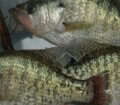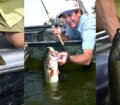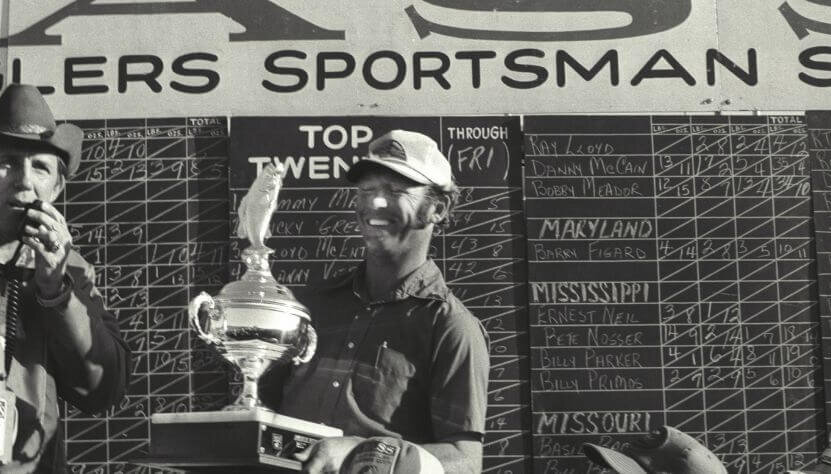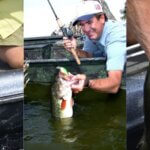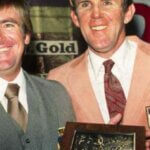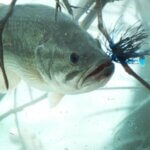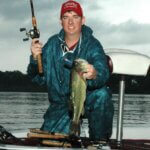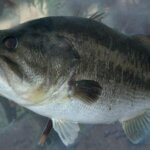Editor’s Note: One of America’s greatest bass fishermen almost vanished from sight when he left competitive bass fishing. However, 72-year-old Larry Nixon from Bee Branch, Arkansas, has come back to Bassmaster. I wanted to know why my longtime friend is returning as well as learn some of his tactics that have made him so successful for 46 years of competitive bassing. Nixon first began tournament bass fishing at the age of 27, while guiding part time. He then joined Bassmaster in 1987. He’s fished 25 Bassmaster Classics, including winning the 1983 Bassmaster Classic and the coveted title of Angler of the Year for two years. He’s won major bass tournaments with Bassmaster, Major League Fishing (MLF) and the FLW circuits for total tournament monies of $3.8 million.
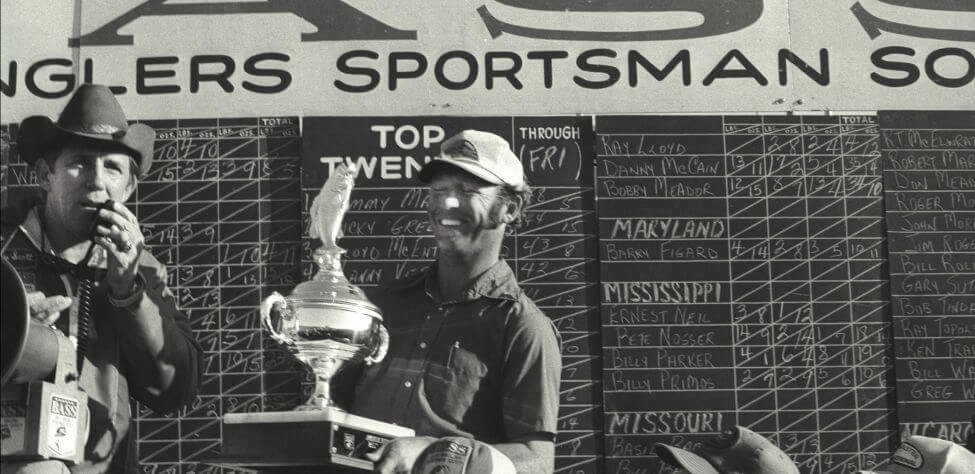
John E. Phillips: Larry, why and how did you decide to become a tournament bass fisherman?
Larry Nixon: A tournament angler and good friend of mine, Tommy Martin, convinced me that no one else in the world could catch or find as many bass as I could. I was guiding on Toledo Bend Lake at the time, and Tommy told me, “Larry, you need to give-up your guiding business and just become a tournament fisherman.”
Phillips: Why did you decide to join Bassmaster?
Nixon: Tommy and a lot of my friends already had joined and had begun fishing Bassmaster tournaments. At that time, to fish in a Bassmaster tournament, you had to join the organization first. I joined in December, 1976, and fished my first Bassmaster tournament in January, 1977. I then fished every one of their tournaments possible for 24 years and fished the FLW circuit, before joining Major League Fishing (MLF).
Phillips: Larry, you’ve outlasted most tournament fishermen. What has enabled you to become one of the GOATS (Greatest of All Times) of bass fishing? What causes you to continue to run the roads and fish tournaments at 72-years old?
Nixon: Well, I:
- love to bass fish, so I want to keep on fishing tournaments;
- I have no need to retire if I feel like I’m still competitive and have a chance to win tournaments and money. I continued to qualify for the MLF Championship tournaments until 2022 – when I missed the mark by two points. One of the reasons I’ve returned to Bassmaster is that I’d like to compete in at least one more Classic before I officially retire. I’ve fished in 25 Bassmaster Classics; and there’s nothing like the feeling you get from fishing against the best of the best in a tournament.
Phillips: How have you been able to stay competitive for 46 years and remain at the highest level of the Bassmaster, the MLF and FLW circuits?
Nixon: I started to learn how important spinning tackle was to successful bass fishing in the 1970s and then began to develop the necessary skills to do it. Well, this spinning-tackle technique and 8-pound-test line have been part of my mainstay techniques all these years. When bass fishing becomes tough and getting a bite is difficult, I’ll pull out my spinning tackle because besides catching bass, the spinning rod reduces a lot of wear and tear on an angler’s shoulders, wrists and arms. I’ve had six bass-fishing-related surgeries. I know when I get in trouble (behind) in a tournament, I can pull out my spinning rod and reel and 8-pound-test line and make bass bite.
Phillips: What pound test line are you primarily fishing now and why?
Nixon: I’m using 12-pound-test braided line and 10-pound-test fluorocarbon.
Phillips: What have been your go-to lures for bass throughout your career?
Nixon: A shaky-head worm (in the mid-1970s, we just called them jig-head worms), is primarily what I’ve fished and been very successful with it. When I won a tournament on Lake Sam Rayburn in Texas, bass fishermen didn’t know how to rig a weedless worm. From 1981-1983, catching bass on that lake became very difficult because the lake was like the Dead Sea – it still had grass, but not very many bass. Tommy Martin and I later learned that we could wear the bass out and catch them on a jig-head worm – especially in May because of their being postspawn bass. I never caught a bass using casting tackle in any tournament I won. Every bass I caught was on spinning tackle when I won. So, even today, a jig-head worm (shaky-head worm) is my number-one lure of choice.
Phillips: What are your favorite colors for shaky-head worms?
Nixon: Green pumpkin, black grape or Junebug are my favorite colors of shaky-head worms. These colors seem to produce bass on every lake I fish. I once won a Lake Sam Rayburn tournament with a Junebug-colored straight-tail worm (the Scoundrel) made by Crème. Today, I’m using a Yamamoto Senko Kut Tail trick worm.
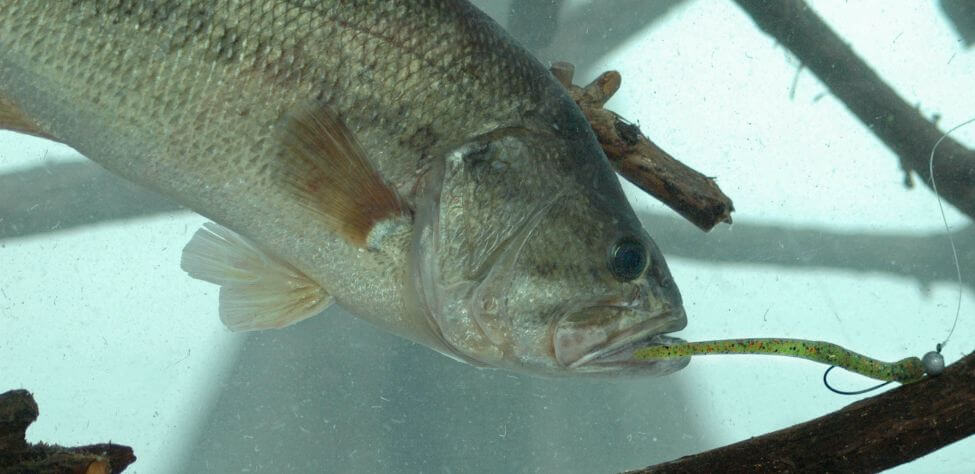
Phillips: What size jig head are you fishing?
Nixon: 90% of the time I’ll use a 1/8-ounce shaky head because it’s light enough to fish in shallow water and heavy enough to fish down to 20 feet. If the wind’s not blowing hard, I’ll fish this worm more than any other. But if there’s a lot of wind, I’ll choose a 3/16- or a 1/4-ounce jig head.
Phillips: What other lures have been your go-to’s when fishing tournaments?
Nixon: A regular jig is next because the jig and the jig-head worm are the two lures in which I have the most confidence. I’ve caught the most bass/big bass on those lures. These lures aren’t difficult to work with and both produce big bass. However, the spinner bait is the best for most anglers to find and catch bass, especially on windy days. Although, when the wind dies down, you can’t beat the shaky or the jig head for catching bass. When the shaky-head isn’t working, I’ll fish worms rigged Texas- or Carolina-style and catch bass.
Phillips: Why is the jig your number-two choice of a bass-fishing lure?
Nixon: A jig is a big-bass bait, and you’ll get reaction bites when the feeding bite isn’t happening. If you put the jig on the bass’s head (cast so close to the fish that it has to eat the jig) – especially when the feeding period is over – he’ll eat a jig. Bass tournament pro Tommy Martin and I believe that you must have two lures that have been successful with catching big bass and that give you confidence to win a tournament. Tommy Martin used to say, “Larry, if we don’t have a jig or a worm bite, we’re in a lot of trouble for any tournament we fish.” I found that he was absolutely right back then and is absolutely right today. Tommy and I often roomed together, traveled and fished together. He was what I called, “My running buddy.”
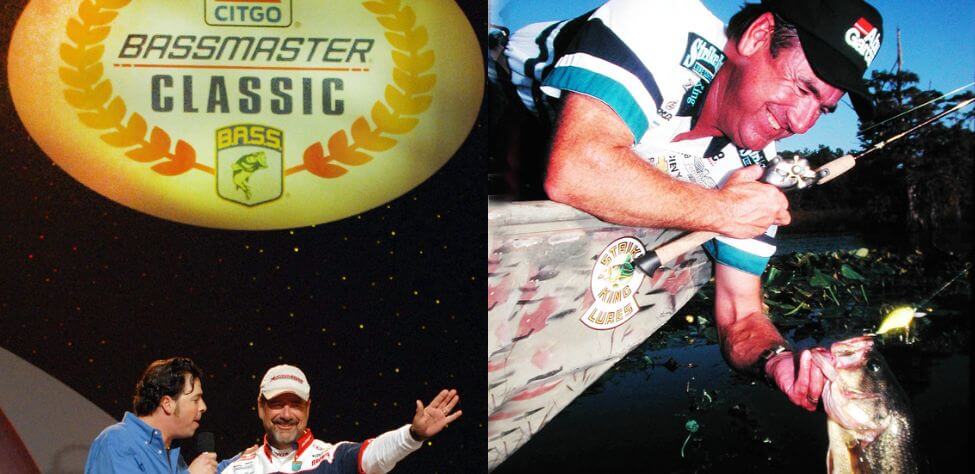
Phillips: What kind of jig do you use to catch bass, and how do you work it?
Nixon: The Stanley 1/2-ounce black/blue jig always has been my standard. At times, I’ll fish a brown jig if the black/blue isn’t working. In the old days of tournament bassing, those colors were the best to fish in a 1/2-ounce jig head. The 1/2-ounce remained the most-popular size for many years. I’ve learned that the mood of the bass dictates the size of the jig head I use. For instance, if the bass are hard to catch, I may fish a 3/4- or a 9/16-ounce jig head and get more bites.
Remember, there’s been a number of changes and innovations since the early days of my bass fishing career. I’ve learned that bass fishing is always changing.
Phillips: What type of trailer do you use on a jig and why?
Nixon: In the early days, we used an Uncle Josh Pork Frog Jig Trailer as this was about the only company that made a trailer for a jig. Then, manufacturers started making soft, plastic trailers and today, they have become so lifelike that I’m using one by Yamamoto on the backs of my jigs. At times, I will use a Zoom Big Salty Chunk as I want to be fishing a big, bulky bait. I feel it will catch more bass than a more-streamlined bait.
Phillips: In tournaments, when you get in trouble or behind in your fishing, what lure do you go to most of the time?
Nixon: When the water’s somewhat deeper, or the bass aren’t biting, I start fishing with a spinning rod, a shaky-head worm and spinning tackle. I also may use a drop-shot worm, as well as a shaky-head, a Texas- or a Carolina-rigged worm in somewhat deeper water and/or when the bass aren’t biting. I just don’t believe there is a better lure to catch bass than using a worm one of those ways.
Tomorrow: Larry Nixon’s Bassing Rods and Reels
Expert Guidebooks on Bass Fishing: Best Sellers

If you want to become the best you can be, find someone who’s already become the best at what you want to do and follow his or her instructions. This is what I’ve done in my new book, Bass Pros’ Season by Season Tactics.
In this book, I’ve chosen some of the best bass fishermen to give you advice on how to find and catch bass during each period of a bass fish’s life, including professionals like Kevin VanDam, Denny Brauer, David Fritts, Rick Clunn, Larry Nixon, George Cochran, Mark Davis, Woo Daves, Gary Klein, Davy Hite, Michael Iaconelli, Skeet Reese, Mark Rose, and Shaw Grigsby.
My hope is that this book will help you find and catch more bass at every time of the year and each day you’re on the water. The men included in this book are some of the best mentors I know of for successful bass fishing anywhere in the nation.
VERSIONS: AUDIBLE & PRINT
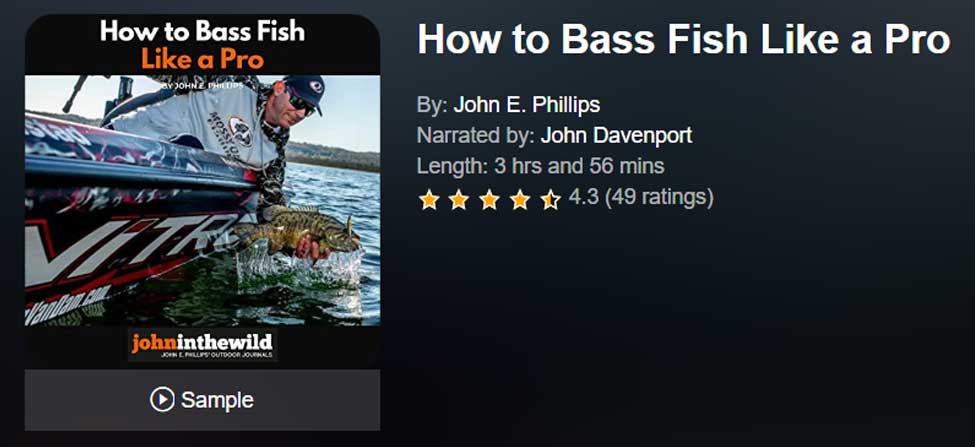
How to Bass Fish Like a Pro
If you could sit down and interview some of the best pro bass fishermen in the world, what would you want them to tell you to help you improve your bass fishing skills?
In this book, How to Bass Fish Like a Pro, Kevin VanDam explains how he catches bass consistently, and how he fishes all 12 months of the year. In the bonus chapters, he will tell you how to fish for hot-weather bass.
Denny Brauer will tell you the ways he hates to fish, how he picks the best fishing lures for different water and weather conditions, and will give you his best fishing tips for hot weather. In Brauer’s bonus chapters, he’ll teach you when to flip a jig, a tube, or a creature bait and tell you his three tips for how to be a better fisherman.
Mark Davis, in Chapter 3 of the book, explains his five secrets to becoming a better bass fisherman, how to turn your bass fishing around to the positive side, and how to catch hot-weather bass. In the bonus chapter, you’ll get six different interviews with Davis, where he tells you: three tips for becoming a better bass fisherman; his three favorite bass lures; and how to keep a big bass on the line and get it to the boat.
James Niggemeyer tells you how to become a bass pro. He also tells you how to catch bass when the weather sizzles. In Niggemeyer’s bonus chapter, he explains how to move from being a bass-club fisherman up to being a pro.
Mark Rose will explain his five favorite go-to bass lures, and how to catch bass in the middle of the summer.
In this book, you’ll hear from top-performing pro fishermen about how they catch big bass consistently, and what they do to win millions of dollars as professional bass fishermen.
VERSIONS: AUDIBLE, KINDLE & PRINT
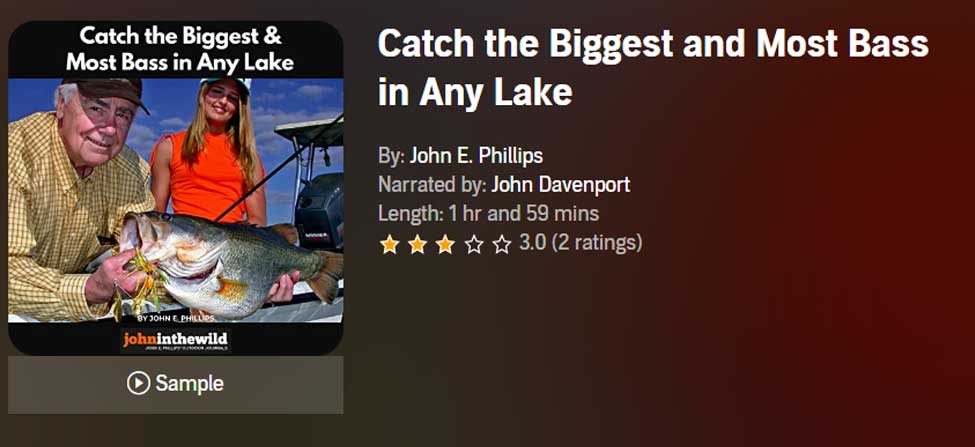
Catch the Biggest and Most Bass in Any Lake
If you were having open-heart surgery at the hospital, you’d want the best doctor with the most experience and the latest equipment and techniques that money could buy to do your operation. You’d study these doctors’ credentials to learn who was the best.
This is the same type of research that author John E. Phillips has done with the best bass fishermen in the nation to solve the problem of how to find and catch the biggest and the most bass in any body of water that he fishes.
This is the same type of research that author John E. Phillips has done with the best bass fishermen in the nation to solve the problem of how to find and catch the biggest and the most bass in any body of water that he fishes.
In this book, you’ll hear about the techniques, tips, baits, lures, and tackle that 18 of the nation’s best professional fishermen use to support their families by winning bass tournaments and catching the most and the biggest bass they can in every tournament they fish.
Most of these anglers are Bassmaster Classic winners, Megabucks winners, Angler-of-the-Year and FLW Tour winners – like Rick Clunn, Kevin VanDam, George Cochran, Mark Davis, Paul Elias, Skeet Reese, Larry Nixon, Hank Parker, Ken Cook, Denny Brauer, Alton Jones, and Jay Yelas.
Also, every serious bass fisherman should know Timmy Horton, Mark Rose, Randy Dearman, Harold Allen, Mike Wurm, and Shaw Grigsby, men whose tactics you’ll find in this book. To learn how to fish for bass and change your bass-fishing trips from fishing trips to catching trips, this book is a must-have.
VERSIONS: AUDIBLE, KINDLE & PRINT
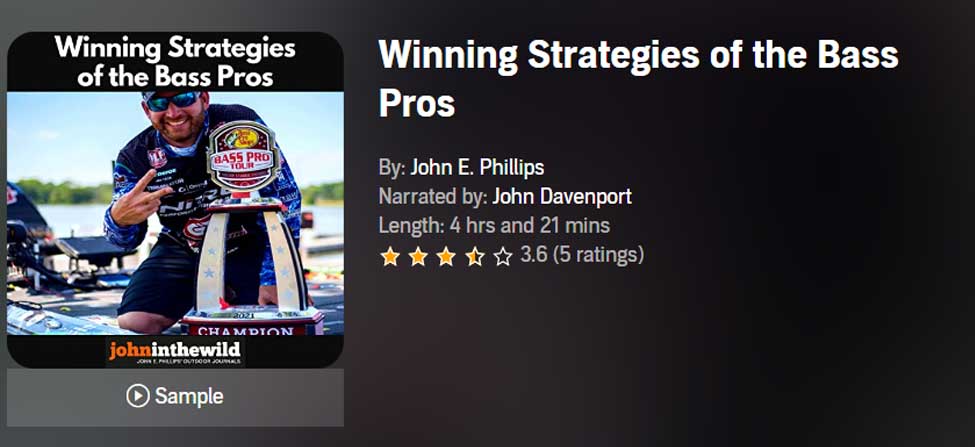
Winning Strategies of the Bass Pros
I learned many years ago if you want to be the best you can be, then you need to learn from the best – particularly when you want to be the best bass fisherman possible. That’s why I’ve written Winning Strategies of the Bass Pros about 11 top bassers.
If you’re wondering at what age you can start learning about bass fishing, you’ll see in the first two chapters about two young men who have come up through the ranks of collegiate bass tournaments – Jordan Lee, who won the Bassmaster Classic in 2017, and Dustin Connell, who won $100,000 in a B.A.S.S. Elite Series tournament in Mississippi in 2017. Top-name pros on both the B.A.S.S. circuit and the FLW circuit are in this book, including Kevin VanDam, Jay Yelas, George Cochran, Rick Clunn, Larry Nixon, Woo Daves, Randy Howell, Scott Canterbury, and Gary Klein.
VERSIONS: AUDIBLE, KINDLE & PRINT
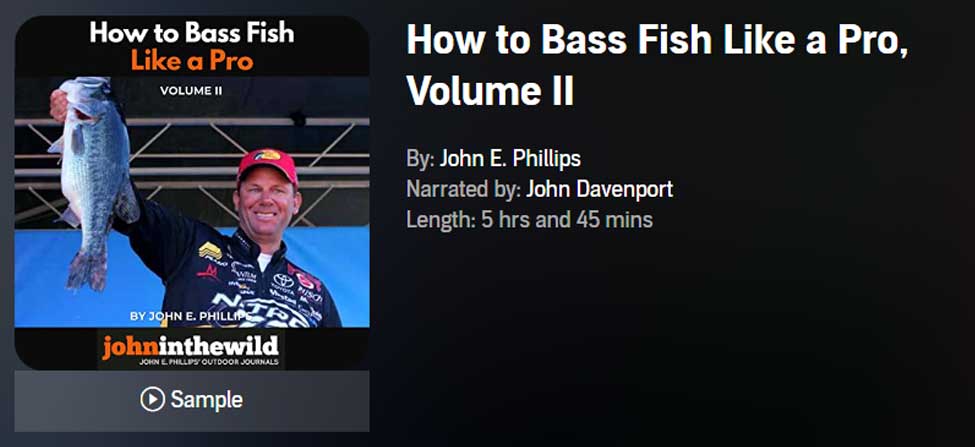
In How to Bass Fish Like a Pro, Volume II, you’ll learn tips and tactics from 21+ Bassmaster Classic winners, two Major League Fishing champions, and 20+ Bassmaster Anglers of the Year about some of the dramatic changes in bass fishing, like:
Depth Finders: You need the latest and greatest depth finders available, since they’re the brains of a bass boat with maps, GPS, side scanning, down scanning, and forward scanning features that enable you to see underwater structures and fish 100-feet away with a 360-degree view. Today’s competitive bass anglers may have four or five depth finders located on the consoles and the bows of their boats.
Other Changes in Equipment: Power fishing for bass using heavy line and rods, big baits, and bait-casting reels that resemble winches have given way to finesse fishing and new techniques like fishing the Ned Rig, the Neko Rig, the Chicken Rig, and the Tokyo Rig on spinning tackle and line as small as 6-10 pounds.
The Growth in Youth and College Competitions for Bass: A young person can begin competition fishing as early as the second grade and continue throughout high school. After that, if the competitor qualifies, he/she may win a scholarship to fish on a college team that eventually may lead them to a professional bass-fishing career.
Changes in the Ways Anglers Bass Fish: Many of the most-consistent winners never pick-up their rods to fish during pre-fishing. Instead, they’ll idle across the water, dropping waypoints from their electronics in places where they’ve identified schools of bass holding. These contestants will have at least 50-250 locations, where they’ve pinpointed schools of bass before a tournament starts.
VERSIONS: AUDIBLE, KINDLE & PRINT

